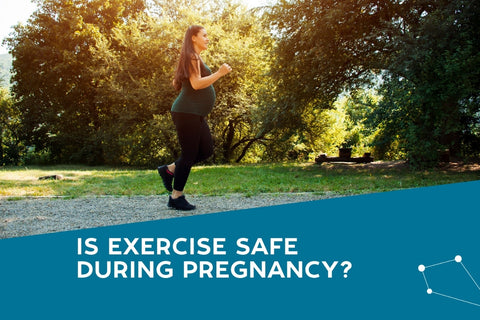It was once thought that exercising during pregnancy would increase the risk of premature labour or result in growth restriction of infants born to exercising mothers. However, modern research has shown that performing aerobic exercise and moderate-intensity exercise (strength/toning) 3-4 days a week throughout the entirety of pregnancy is not associated with any of these risks, and does not increase complications of pregnancy or childbirth. Regular exercise during pregnancy has not only been shown to positively affect physical outcomes for the mother, but may also result in psychological and social benefits as well. Deep vein thrombosis, obesity, gestational diabetes, preeclampsia, sleep apnoea, low back pain, pelvic girdle pain, urinary incontinence, preterm birth and even still birth have all been associated with long-term sedentary lifestyles during pregnancy.
The mother does need to be cleared by their GP before engaging in physical activity, because the benefits of remaining active (as long as you are physically able to) outweigh the associated health risks of living a sedentary lifestyle whilst pregnant.
If the mother was already engaged in regular physical activity before falling pregnant, it is usually acceptable to continue a similar routine during pregnancy. However, it is also important to adapt an exercise regime to comply with how you feel, and lowering intensity as appropriate. It is also important to ensure safety is a high priority and to limit the risk of falls and trauma wherever possible.
Avoid overheating
It is important for the mother to avoid overheating, as preventing excess exposure to heat or humidity is crucial to ensure that adequate hydration is maintained. Drinking water prior to and during exercise will assist in avoiding dehydration and overheating. Strenuous aerobic exercise, overexertion, running and heavy lifting are not recommended as they could divert blood flow away from the foetal placenta for the sake of perfusing vital maternal organs during strenuous activity.
Contraindications
Below are important contraindications to exercise that should be taken seriously. If you are affected by any of these conditions you should consult your doctor before engaging in regular or intense physical exercise:
- Placenta previa
- Incompetent cervix
- Bleeding during 2nd or 3rd trimester
- Preterm labour
- Heart or lung disease
- Hypertension
- Preeclampsia
- Severe anaemia
- Preterm premature rupture of membranes
Safe exercises during pregnancy
- Cycling on a stationary bike (reduces the risk of losing balance and falling)
- Swimming (provides buoyancy and eases sore joints)
- Yoga and Pilates (excellent for strengthening and stretching muscles, reducing pain as well as improving mental health)
- Walking
- Light resistance activities
- Dancing
Recommendations
As stated from the Department of Health, as long as the mother and the child are healthy, meeting the physical activity guidelines during pregnancy means being active most days, if not every day of the week. Ideally exercise should total:
- 2.5 to 5 hours of moderate intensity physical activity; or
- 1.25 to 2.5 hours of vigorous intensity physical activity; or
- An equivalent combination of moderate and vigorous activities
- Muscle strengthening activities on at least 2 days per week (light resistance training or bodyweight exercises)
Pelvic floor activities
Urinary incontinence after vaginal birth is common, and occurs in almost half of all women. Incontinence affects not only physical wellbeing but also impacts social and psychological wellbeing and may result in decreased quality of life. Training the pelvic floor muscles throughout the perinatal period is an important and effective method to assist in the prevention of urinary incontinence experienced postpartum due to the weakened muscles of the pelvic floor. Studies have shown improvements in function after just 6 weeks of training and recent scientific reviews have documented a reduction in incontinence by 29-37% for women who exercised their pelvic floor during pregnancy. Combining this training with aerobic exercise results in additional benefits compared to pelvic floor training alone.
Pre-pregnancy activities
Every woman will be different after childbirth. Different methods of delivery will mean different lengths of recovery and it is important to not feel under pressure to ‘bounce back’. A gradual return to activity is generally safe after the 6-week postnatal check-up, however this will be different for everyone. You should also not feel pressured to compare yourself to anyone other than yourself and be guided by your own experience. Enjoy this time with your bub and your little family!
Resources:
1. Australian Government. Department of health – physical activities and exercise for pregnancy. https://www.health.gov.au/health-topics/physical-activity-and-exercise/pregnancy
2. Cooper DB, Yang L. Pregnancy And Exercise. 2021 Apr 26. In: StatPearls [Internet]. Treasure Island (FL): StatPearls Publishing; 2021 Jan–. PMID: 28613571.
3. Sanabria-Martínez, G., Poyatos-León, R., Notario-Pacheco, B., Álvarez-Bueno, C., Cavero-Redondo, I., & Martinez-Vizcaino, V. (2019). Effects of physical exercise during pregnancy on mothers' and neonates' health: a protocol for an umbrella review of systematic reviews and meta-analysis of randomised controlled trials. BMJ open, 9(9), e030162. https://doi.org/10.1136/bmjopen-2019-030162
4. Szumilewicz, A., Kuchta, A., Kranich, M., Dornowski, M., & Jastrzębski, Z. (2020). Prenatal high-low impact exercise program supported by pelvic floor muscle education and training decreases the life impact of postnatal urinary incontinence: A quasiexperimental trial. Medicine, 99(6), e18874. https://doi.org/10.1097/MD.0000000000018874


